Have you explored the recently released Digest of Education Statistics 2019? The Digest is a great resource for education data on a range of topics from a variety of sources. Because of the report’s size (the 2019 edition has more than 700 tables across 7 chapters), it can sometimes be a bit tricky to find the data you need. Read on to discover some tips for navigating the Digest website.
Finding the Most Recent Versions of Tables
There are several ways to find the most recent version of a table, depending on what page you are on. From the Digest landing page, click on “Most Current Digest Tables” (figure 1). From the list of tables page for a specific year, use the drop-down menu to select “Current” (figure 2).
Figure 1
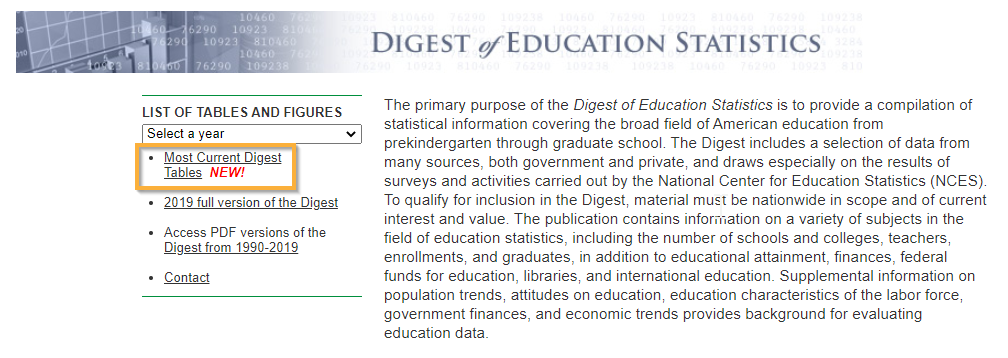
Figure 2
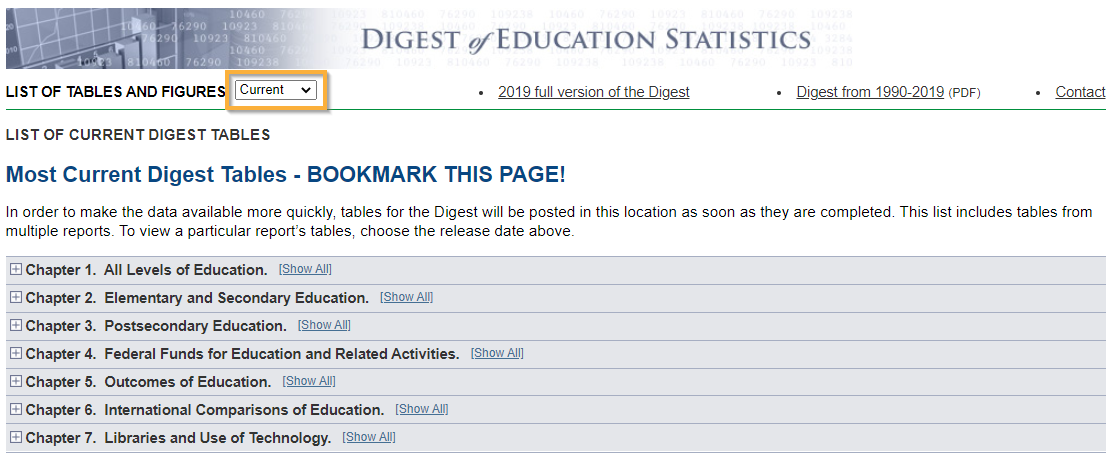
- Tip: If you navigate to a table from a search engine, you may not be on the most recent year. Check for a “Click here for the latest version of this table” option in the top righthand corner of the table’s page.
Finding Tables Using the Digest Indexing System
Have you ever navigated to a Digest table from a search engine or another NCES report and wanted to find other similar tables? What should you do if a Digest table covers a topic you want to learn about but does not include the specific data you need? You can use the Digest indexing system to find other similar tables.
The Digest indexing system is based on numbered chapters and topical subsections. Each table identifier contains the chapter number (1 through 7) followed by the subsection (e.g., 01, 02, 03) and the table number after the period (e.g., .10, .20, .30). For example, table 601.10 is the first table in chapter 6 under “Population, Enrollment, and Teachers,” which is subsection 01 (figure 3).
Figure 3
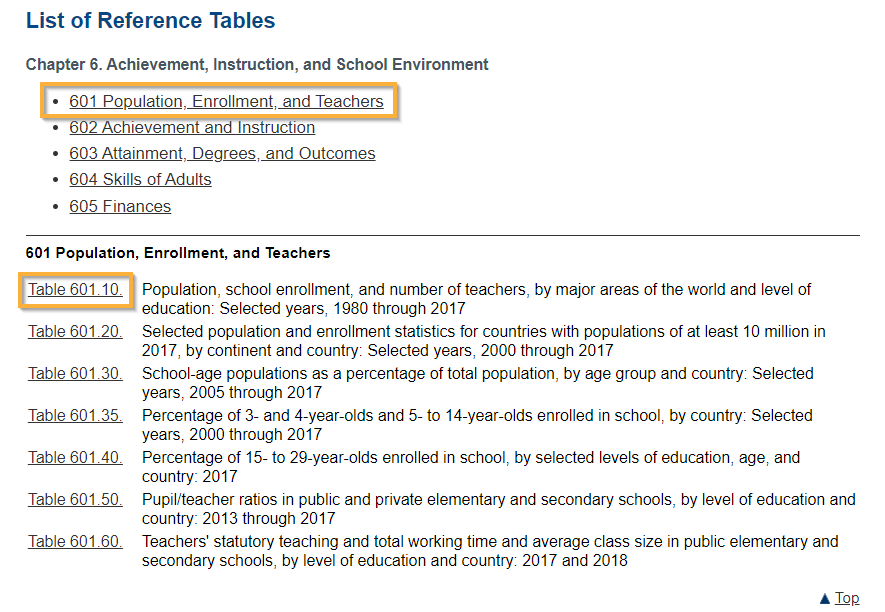
To find tables similar to the one you have found already, click on the link at the top left of the table’s page, which will take you to a full list of tables for the Digest edition you are viewing. For example, a Digest 2019 table will feature a “2019 Tables and Figures” link at the top left of the table (figure 4).
Figure 4
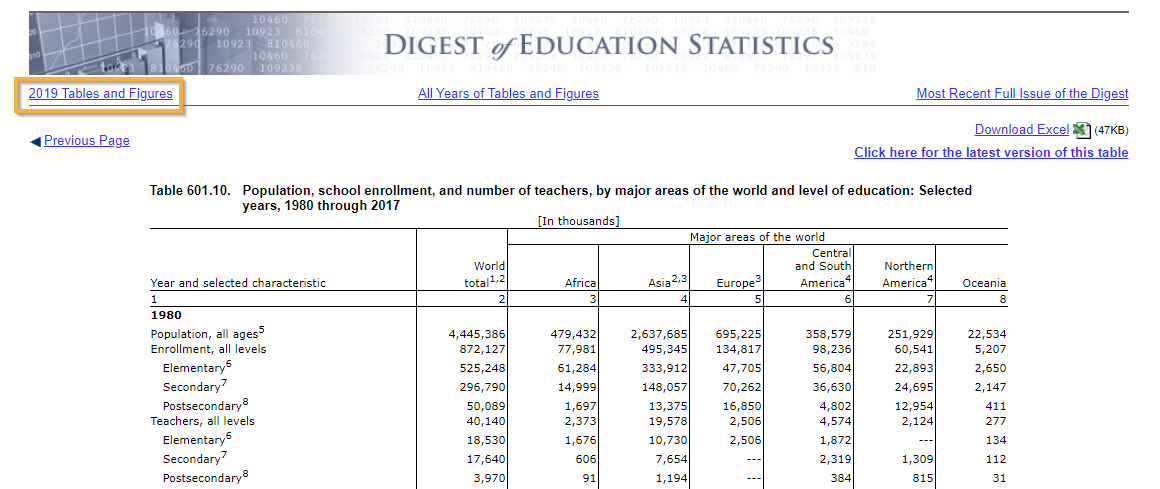
From here you can navigate to the relevant chapter and subsection using the indexing system. For example, if you were viewing table 601.10 and wanted to find other similar tables, you would click the + sign next to “Chapter 6. International Comparisons of Education” and then click the + next to “601 Population, Enrollment, and Teachers” (figure 5). You can then click through and explore all the relevant tables in that subsection.
Figure 5
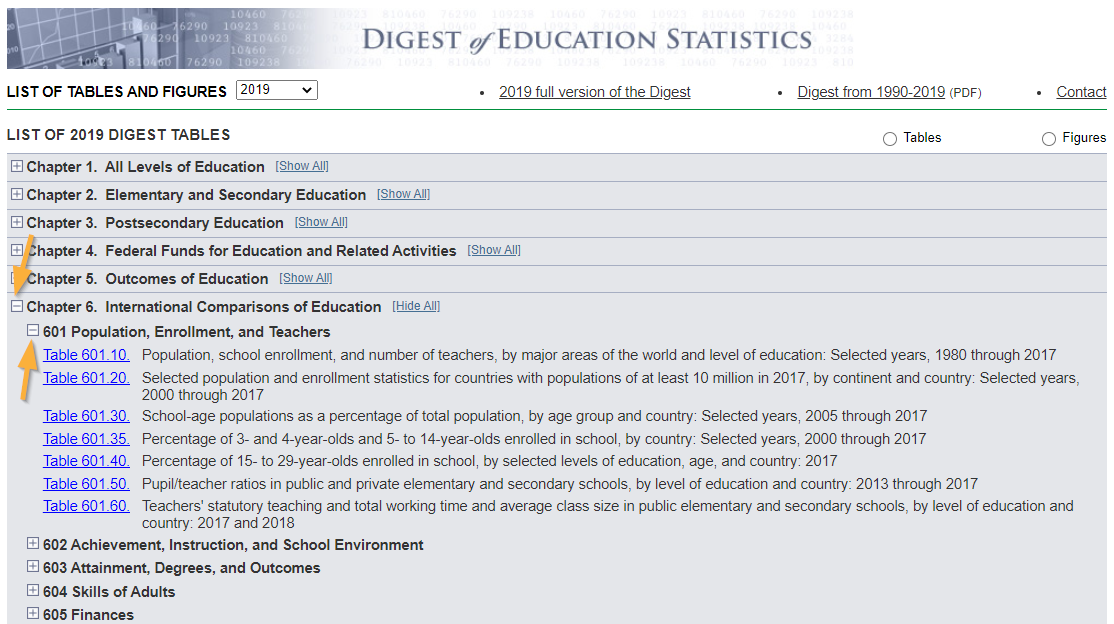
- Tip: Use the radio buttons at the top right to toggle between viewing tables and figures.
- Tip: Use Ctrl + click to open tables in a new tab to avoid losing your place on the page.
If you do not see a table with the information you need, remember that the SOURCE note of a Digest table can be a great way to find related resources. Scroll to the bottom of a table to find the data sources used to prepare it.
Searching for Key Terms or Phrases Across All Tables
What if you want to search the Digest by topic instead of starting with a specific table? One easy way to do so is to navigate to the “List of 2019 Tables Page” and click “Show All” next to each chapter (figure 6).
- Tip: Start at chapter 7 and work your way up to avoid having to scroll.
Figure 6

Once the tables are displayed for each chapter, you can easily do a global search of the entire page (Ctrl + F) and search for the term or phrase of your choice.
- Tip: Try a few different search terms if you do not find what you are looking for right away. For example, the Digest uses the term “distance education” for remote learning.
Accessing Older Versions of Tables
In addition to the current edition of the report, the Digest website also contains archives of each report through 1990. You can access previous editions of the report in several ways (figure 7):
- Select a year from the drop-down menu to access the HMTL versions of that year’s tables.
- Click on “Access PDF versions of the Digest from 1990–2019” to access archived PDF files.
- From here, you can click the + next to “Digest of Education Statistics” and select the report you want to view.
Figure 7

In addition to trying these tips for navigating the Digest website, you can explore the Reader’s Guide and Guide to Sources to learn more about the data sources used in the report. The Reader’s Guide also provides additional information about common measures and indexes, data analysis and interpretation, limitations of the data, and other aspects of the report.
By Megan Barnett, AIR